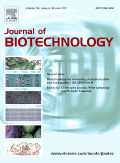
JOURNAL OF BIOTECHNOLOGY
Scope & Guideline
Driving excellence in biotechnological research and applications.
Introduction
Aims and Scopes
- Biological Engineering and Synthetic Biology:
Research in this area involves the engineering of biological systems to create new functionalities, including the design of genetic circuits and synthetic pathways for the production of biopharmaceuticals, biofuels, and other valuable compounds. - Molecular Biology and Genetic Engineering:
This scope includes studies on gene cloning, expression, and modification techniques (e.g., CRISPR/Cas9), which are pivotal for developing transgenic organisms and exploring gene function in various biological systems. - Bioprocess Development and Optimization:
Focus on the optimization of biotechnological processes, including fermentation and cell culture systems for the production of recombinant proteins, enzymes, and metabolites, emphasizing efficiency and sustainability. - Environmental Biotechnology:
Research that addresses bioremediation, waste management, and the use of microorganisms for environmental restoration, highlighting innovative approaches to tackle ecological challenges. - Nanobiotechnology:
Exploration of the application of nanotechnology in biotechnology, including the development of nanoparticles for drug delivery, biosensing, and antimicrobial applications. - Bioinformatics and Computational Biology:
Utilizing computational tools and methods to analyze biological data, including genomic and proteomic studies, to uncover insights into biological systems and disease mechanisms. - Plant Biotechnology:
Studies focusing on plant genetic engineering, secondary metabolite production, and stress resistance mechanisms, contributing to agricultural advancements and food security.
Trending and Emerging
- CRISPR and Genome Editing Technologies:
The use of CRISPR/Cas9 and other genome editing tools has surged, allowing for precise genetic modifications in various organisms, with significant implications for medicine and agriculture. - Nanoparticle Applications in Medicine and Agriculture:
Research into the synthesis and application of nanoparticles has expanded, particularly in drug delivery systems, imaging, and as antimicrobial agents, highlighting their versatility and effectiveness. - Bioinformatics and Systems Biology Approaches:
There is an increasing reliance on bioinformatics for data analysis and systems biology to understand complex biological networks, particularly in the context of cancer and metabolic diseases. - Sustainable Biotechnology Practices:
A growing emphasis on environmentally friendly biotechnological processes, including bioremediation and the use of renewable resources, reflects a broader shift towards sustainability in research. - Metabolomics and Functional Genomics:
Emerging interest in metabolomics as a means to understand metabolic pathways and their regulation is gaining momentum, offering insights into plant and microbial biotechnology. - Microbiome Research:
Investigation of microbial communities and their interactions with hosts is increasingly relevant, particularly in health, agriculture, and environmental contexts, driving new avenues of research.
Declining or Waning
- Traditional Microbial Fermentation Processes:
Research focusing on conventional fermentation techniques has seen a decline as newer, more efficient methods and microbial strains are developed, emphasizing the need for innovation in bioprocessing. - Plant Tissue Culture Techniques:
While still important, traditional plant tissue culture methods have been overshadowed by advancements in genome editing and synthetic biology approaches, which offer more precise and efficient means of plant improvement. - Basic Enzyme Characterization Studies:
The focus on merely characterizing enzymes without exploring their applications or engineering has waned, as there is a growing emphasis on applied research that leads to practical biotechnological solutions. - Classic Genetic Mapping Techniques:
With the advent of high-throughput sequencing technologies, traditional genetic mapping methods have decreased in use, as researchers now prefer more comprehensive genomic approaches.
Similar Journals

Journal of Genetic Engineering and Biotechnology
Pioneering Research for Tomorrow’s Genetic SolutionsJournal of Genetic Engineering and Biotechnology, published by Elsevier Science Inc, is a prestigious open-access journal that stands at the forefront of research in the fields of biotechnology and genetics. Since its inception in 2011, the journal has provided a platform for cutting-edge studies that explore the complexities and innovations within genetic engineering and its applications in biotechnology. With a commendable Impact Factor and recognized as a Q2 journal in both biotechnology and genetics as per 2023 categorization, it ranks well within Scopus, evidencing its influence in the scientific community. Researchers and professionals accessing articles published in this journal benefit from timely contributions that bridge theoretical and practical aspects of genetic technologies. By fostering a collaborative environment, the Journal of Genetic Engineering and Biotechnology aims to promote advancements that drive science forward, making it an essential resource for students, academics, and industry practitioners alike. For those interested in making their mark in these rapidly evolving fields, this journal offers unparalleled access to high-quality, peer-reviewed research.

BIOTECHNOLOGY ADVANCES
Pioneering Innovations in BioengineeringBIOTECHNOLOGY ADVANCES is a premier, peer-reviewed journal published by PERGAMON-ELSEVIER SCIENCE LTD, dedicated to advancing knowledge in the rapidly evolving fields of biotechnology and bioengineering. With an ISSN of 0734-9750 and an E-ISSN of 1873-1899, this esteemed journal covers a wide spectrum of topics relevant to applied microbiology, molecular biology, and biochemical innovation. Recognized for its academic rigor, it holds a distinguished position in the top quartile (Q1) in multiple categories, including Applied Microbiology and Biotechnology, Bioengineering, and Biotechnology, further evidenced by its high rankings in Scopus, where it ranks #3/127 in Applied Microbiology and Biotechnology and #7/311 in Biotechnology. Researchers and professionals in the field value the journal not only for its comprehensive coverage of cutting-edge research but also for its commitment to disseminating critical findings and fostering collaboration. While BIOTECHNOLOGY ADVANCES currently operates under a subscription model, its potential impact on future innovations in biotechnology cannot be overstated, making it an essential resource for anyone interested in the forefront of biotechnological advancements.

BioTech is a forward-thinking academic journal published by MDPI, specializing in the dynamic fields of applied microbiology, biotechnology, biochemistry, bioengineering, and biomedical engineering. Established for promoting impactful research from 2021 to 2024, this journal aims to bridge the gap between laboratory findings and practical applications, serving as a vital resource for researchers, practitioners, and students alike. With its Open Access model, BioTech ensures that groundbreaking innovations are freely available to the global community, fostering collaboration and knowledge transfer across disciplines. In the 2023 rankings, BioTech holds a strong position in Q2 and Q3 quartiles across various categories, reflecting its commitment to high-quality research output. Being indexed in renowned databases, the journal enhances its visibility and reach, making it a preferred platform for sharing transformative ideas and discoveries in biotechnology and related domains. Set against the backdrop of Switzerland’s thriving research environment, BioTech is poised to become an essential resource in the rapidly evolving landscape of life sciences.

Research Journal of Biotechnology
Pioneering research for a sustainable biotechnological future.Research Journal of Biotechnology is a premier publication dedicated to advancing the field of biotechnology through the dissemination of impactful research articles. Published by Research Journal Biotechnology in India, this journal operates under an Open Access model, facilitating unrestricted access to high-quality research for researchers, professionals, and students worldwide. With an ISSN of 2278-4535 and an E-ISSN of 2278-4535, the journal aims to serve as a comprehensive platform for innovative studies in Applied Microbiology and Biotechnology, Bioengineering, and Biotechnology. Despite its current Q4 quartile ranking in these categories, the journal aspires to extend its influence and visibility in the academic community, aiming for greater impact in the future. The journal features research articles that span a wide array of topics in biotechnology, fostering a collaborative and knowledge-rich environment for national and international scholars. We invite you to explore, contribute to, and engage with the expanding landscape of biotechnological research through the Research Journal of Biotechnology.

BIOLOGICAL RESEARCH
Empowering the scientific community with open access.BIOLOGICAL RESEARCH is a prestigious, peer-reviewed journal published by the Société de Biologie de Chile, dedicated to advancing the fields of Agricultural and Biological Sciences, Biochemistry, Genetics, and Molecular Biology, and Medicine. With an impressive ranking in the top quartile (Q1) in these categories as of 2023, this journal maintains high academic standards and visibility, making it a vital resource for researchers and professionals alike. Operating under an Open Access model since 2013, it ensures that research findings are freely accessible to a global audience, promoting the dissemination of knowledge and collaboration across disciplines. With a publication history dating back to 1992 and continued updates until 2024, BIOLOGICAL RESEARCH serves as a crucial platform for innovative research that impacts both scientific and healthcare communities. The journal’s commitment to quality and relevance is evidenced by its competitive performance in Scopus rankings, further solidifying its role as a leading journal within the biological sciences.

ENGINEERING IN LIFE SCIENCES
Exploring Breakthroughs in Biotechnology and Environmental EngineeringENGINEERING IN LIFE SCIENCES, published by Wiley, is a pivotal journal for professionals, researchers, and students dedicated to advancing the interdisciplinary fields of bioengineering, biotechnology, and environmental engineering. With an ISSN of 1618-0240 and an E-ISSN of 1618-2863, this journal has established itself as a reputable platform for disseminating innovative research findings and breakthroughs in engineering applications within the life sciences. Currently holding a prestigious Q2 ranking in multiple categories, including bioengineering and environmental engineering, it reflects a strong commitment to high-quality, impactful research (Scopus ranks: Environmental Science - Rank #61/197, Biochemistry, Genetics and Molecular Biology - Rank #112/311). The journal spans contributions from 2004 to 2024, ensuring a comprehensive archiving of evolving scientific discourse. Although it does not currently offer open access, its curated articles are accessible through institutional and single-article purchases, providing valuable insights and updates for the academic community. Join us in shaping the future of engineering within life sciences and stay informed on critical advancements that are driving innovation across multiple disciplines.

ELECTRONIC JOURNAL OF BIOTECHNOLOGY
Unlocking Knowledge in Applied Microbiology and BiotechnologyThe Electronic Journal of Biotechnology is a premier Open Access journal published by Pontificia Universidad Catolica de Valparaiso, Chile, dedicated to advancing the fields of applied microbiology and biotechnology. With its inception in 1998 and an unwavering commitment to sharing knowledge, the journal has garnered a respectable ranking within the Q3 quartile for both its biotechnology and applied microbiology categories as of 2023, reflecting its significance in the academic community. Researchers and professionals will find its editorial rigor complemented by a robust platform for disseminating innovative findings, fostering collaboration, and driving forward biotechnology discussions. Given its inclusive approach, having transitioned to Open Access in 2014, the journal ensures that research is accessible to a global audience, making it a valuable resource for students, academics, and industry practitioners alike. Through the publication of original research, reviews, and critical insights, the Electronic Journal of Biotechnology aims to bridge the gap between scientific discovery and practical application, ultimately contributing to advancements in health, agriculture, and environmental sustainability.

Synthetic and Systems Biotechnology
Shaping Tomorrow’s Biotechnology LandscapeSynthetic and Systems Biotechnology, published by KEAI PUBLISHING LTD, is a pioneering open-access journal that has made significant contributions to the fields of applied microbiology, biotechnology, biomedical engineering, genetics, and structural biology since its inception in 2016. With an ISSN of 2405-805X, this journal is committed to fostering innovative research and interdisciplinary collaboration, providing a platform for the dissemination of high-quality studies that push the boundaries of scientific knowledge. Recognized for its excellence, it holds prestigious Q1 rankings in both Applied Microbiology and Biotechnology as well as Biomedical Engineering in 2023, alongside notable Q2 rankings in Genetics and Structural Biology. Researchers, professionals, and students alike can access cutting-edge research that explores the dynamic interplay between synthetic biology and systems biology, driving advancements that could reshape health, industry, and environmental sustainability. By operating under an open-access model, Synthetic and Systems Biotechnology ensures that new findings are accessible to a global audience, thereby maximizing the impact and reach of the published work and paving the way for future discoveries.

APPLIED AND ENVIRONMENTAL MICROBIOLOGY
Unveiling the Secrets of Microbial Interactions in Our WorldApplied and Environmental Microbiology, published by the American Society for Microbiology, stands as a leading journal in the fields of applied microbiology and environmental science since its inception in 1976. With a prestigious Q1 quartile ranking across multiple categories including Applied Microbiology and Biotechnology, Ecology, and Food Science, this journal consistently disseminates high-impact research that drives innovation and advances our understanding of microbial interactions within our ecosystems and industries. As ranked by Scopus, it exhibits prominent rankings in various related fields, underscoring its critical role in shaping contemporary microbiological research. Researchers, professionals, and students alike can stay abreast of groundbreaking studies while contributing to a vast body of knowledge that spans diverse aspects of microbiology, biotechnology, and ecology, ultimately contributing to sustainable practices. Join the community of dedicated scholars and explore vital research findings that impact both environmental health and technological advancement.

APPLIED MICROBIOLOGY AND BIOTECHNOLOGY
Empowering discoveries that shape our world.Applied Microbiology and Biotechnology, an esteemed journal published by Springer, serves as a vital resource in the domains of microbiology and biotechnology. With an impressive impact factor reflecting its quality, the journal holds Q1 rankings in various categories including Applied Microbiology and Biotechnology, Biotechnology, and Medicine (Miscellaneous) as of 2023. Spanning the years from 1984 to 2024, it underscores its commitment to disseminating groundbreaking research that addresses pressing challenges in health, agriculture, and environmental sustainability. The journal is rigorously indexed and holds respectable positions in Scopus rankings, notably within the top 15% of Applied Microbiology and Biotechnology and the top 15% in Biochemistry, Genetics, and Molecular Biology. Although it is not Open Access, its comprehensive articles, reviews, and short communications are indispensable for researchers, professionals, and students eager to advance their understanding and application of microbial processes and biotechnological innovations in real-world contexts.